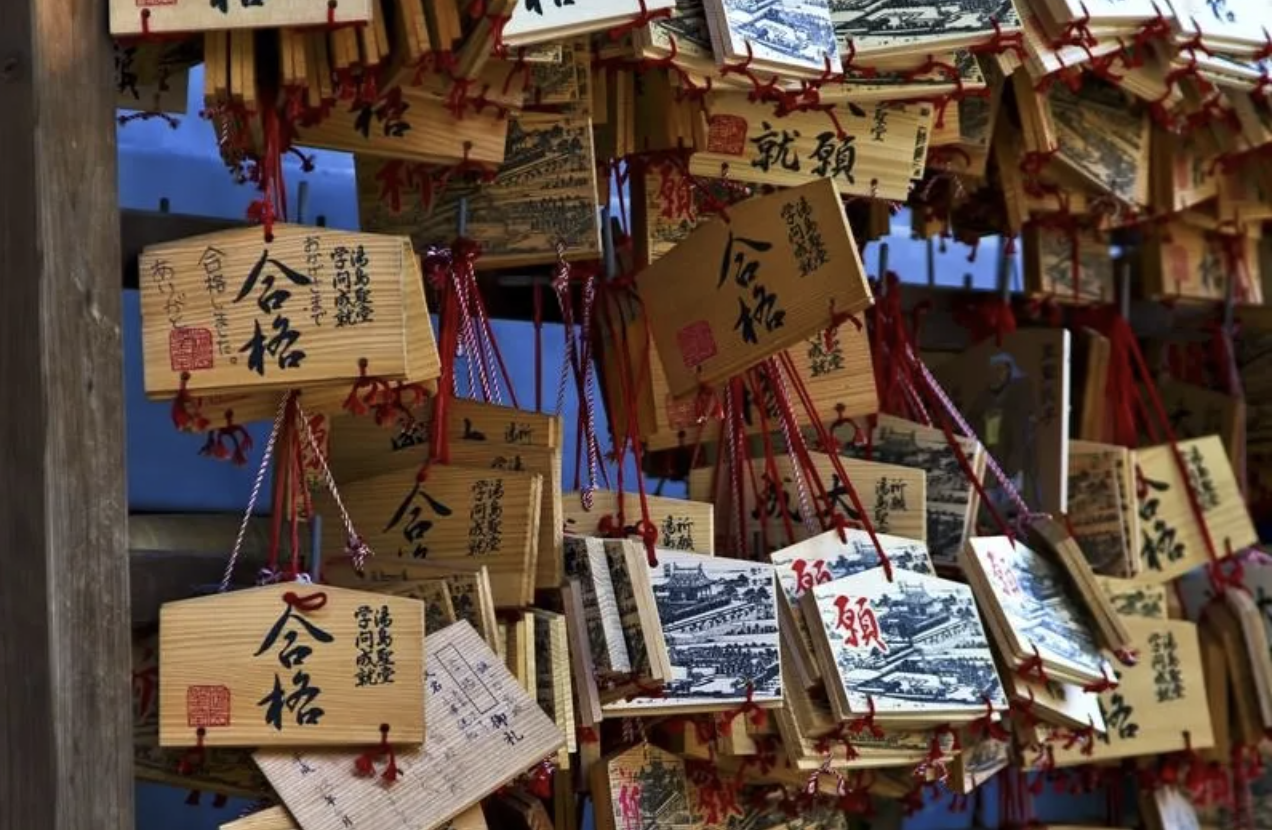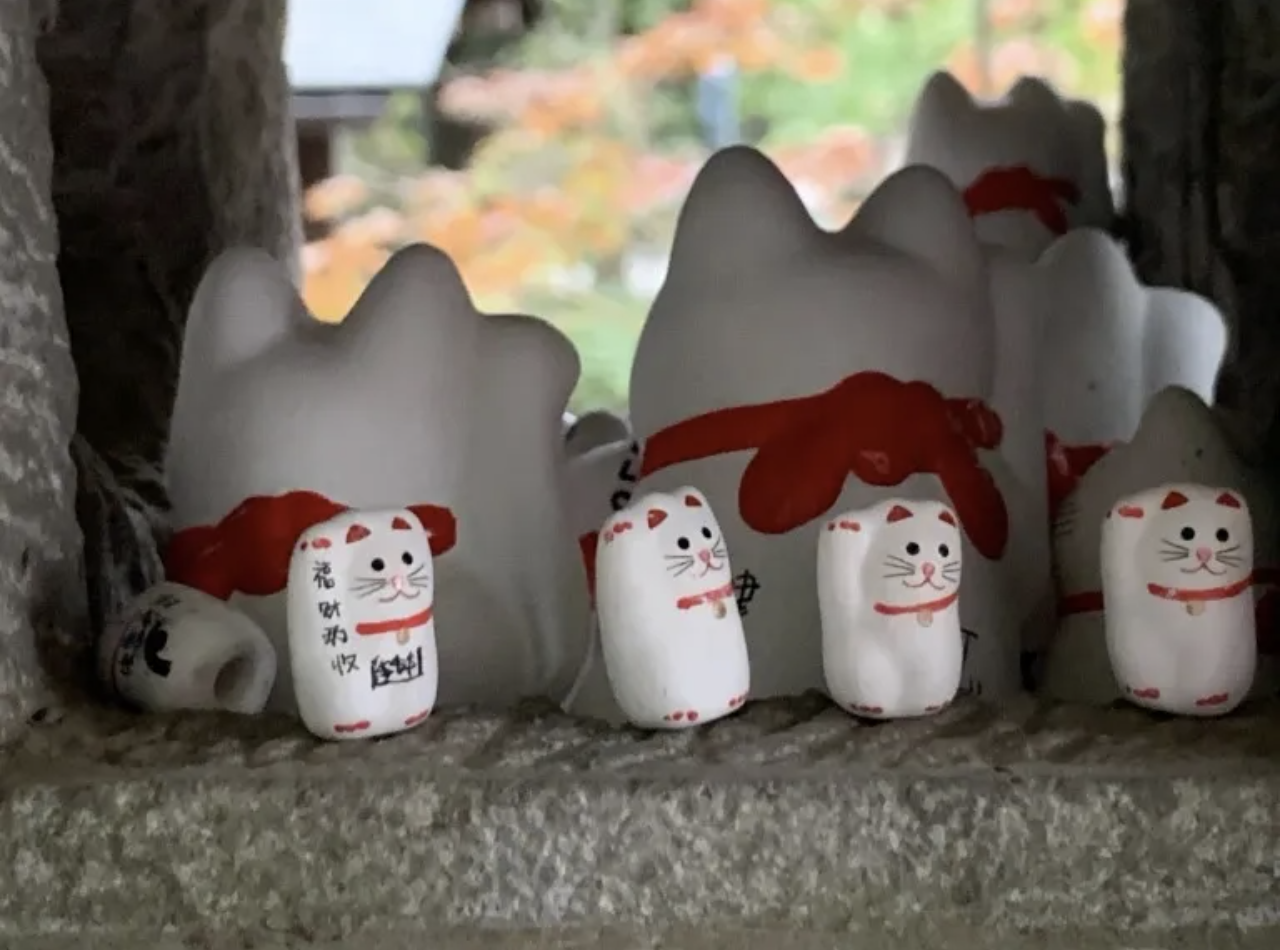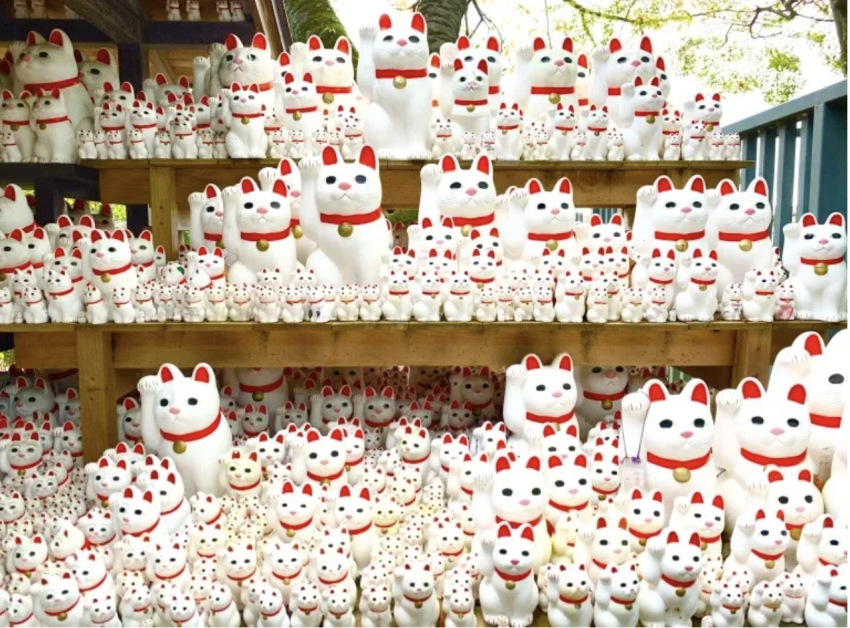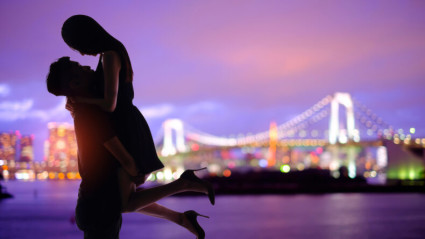Located in Tokyo’s Setagaya Ward, Gotokuji’s name translates to “temple of great virtue.” And sure, as a Buddhist temple, it is a place for the virtuous, but it’s also a place for cat lovers.
That’s because on any given day you can expect to see somewhere around 10,000 manekineko, or “beckoning cat,” figurines on display on the temple grounds.
Legend has it that 400 years ago, when a prominent samurai lord was traveling through the area, he became caught in a violent thunderstorm. Looking for refuge from the lightning that was beginning to fall, the samurai spotted a cat that beckoned to him. He followed it to Gotokuji, where the monks gave him shelter until the storm passed, and in gratitude the samurai became the temple’s providing patron thereafter.
That’s why, to this day, Gotokuji sells beckoning cat figurines in the temple’s store, and recently they’ve become a big hit with visiting foreign travelers, as seen in the news report here.
The temple no doubt appreciates the patronage. Each figurine sells for between 500 and 7,000 yen, depending on size, and the temple says it’s been selling up to 800 in a single day during the ongoing travel boom. However, there’s one thing the temple is less happy about, which is people writing wishes or other messages on the figures.
A woman visiting from Germany, seen at the point cued up in the video here, has written the name of her pet cat on the figurine, which she says she plans to leave at the temple as a wish for her pet’s continued health. Another figurine with a wish for health, written in Chinese, and one with various currency symbols, apparently in hopes of achieving economic prosperity, can also be seen.
The temple says it does not want people to do such things, and has now posted a multilingual written notice, saying: “The cat figurines are sacred items. Please do not scribble on them.”
There are actually a few different unusual aspects to the situation. First, manekineko figurines aren’t usually thought of as sacred within Japanese culture. Yes, they’ve been seen as good luck symbols for hundreds of years, with the cat’s raised paw said to beckon customers to businesses or wellness and wealth to a household. Those purported powers, though, aren’t ascribed to any religious energy or divine authority.
Manekineko aren’t exclusive to Gotokuji, nor did they originate at the temple, so this isn’t a case of a once-sacred object having its air of divinity eroded. Manekineko are readily available in souvenir shops, and while they have the same quasi-supernatural image of any good luck charm, they’re generally seen by people in Japan as a secular one.
At the same time, it is unusual to write wishes on manekineko. Written wishes typically go on ema, wooden boards that are also commonly sold at temples and shrines in Japan, and which are supposed to be hung on a special rack on the temple/shrine grounds to boost their wish-granting powers. Manekineko, on the other hand, are meant to provide a broader, less specific sort of good luck.

So saying “A manekineko is sacred, so don’t write on it” is kind of like saying “A rabbit’s foot is sacred, so don’t write on it.” It’s a stretch to call it sacred…but it’s also weird to write on it.
It’s also worth pointing out that while the behavior of foreign tourists is becoming a topic of increased public awareness as Japan sees record-breaking numbers of inbound international travelers, people writing on their manekineko at Gotokuji isn’t a phenomenon that only started in the post-pandemic travel boom. When we visited the temple in 2019, we saw a few figurines with written messages on them then too.

The temple’s “please don’t write on the manekineko” notice is also written in both English and Japanese, suggesting that the temple feels even locals could possibly use a reminder, as seen at the point in the video here.
Still, even if it’s not only foreigners writing on manekineko, the large number of foreign visitors the temple is getting these days means that even if a small percentage of them are writing on the figurines, there’re going to be enough to get noticed. With the temple having specifically asked that people not write on them, the polite thing to do is to comply with the request. And if the idea of a temple dictating what you can and can’t do with a secular object that you’ve purchased doesn’t sit right with you?
Well, when we visited the temple, they told us that there aren’t any set rules as to whether or not you need to leave the figurine you purchased at the temple for your wish to come true. Taking it home with you provides the exact same boost to your good fortune, they told us, so if you feel like you absolutely have to write on it, it’s probably best to wait until you get home to do so.
Source: YouTube/ANNnewsCH
Read more stories from SoraNews24.
-- A visit to Japan’s cat beautiful, quirky, and touching cat temple, Unrinji【Photos】
-- Invite some luck into your life this year with Furla’s new Little Cats collection of merch
-- Flush your prayers down the toilet at this unique Japanese temple
© SoraNews24















39 Comments
Login to comment
BigP
Well, I won’t visit there then.
sakurasuki
It's not easy to write on unflatten surface like figurine, however since it's their figurine which they own. So they are free to do what they want to write.
JeffLee
The temple folks need to take a chill pill.
aaronagstring
No they aren’t. They’re cat figurines. That you charge money for. That you want people to buy. That you sell. For profit. So much for it being sacred.
dbsaiya
So petty. They bought it, they can write on it. What's wrong with writing a pet cat's name on it for its good health? If it brings solace to the individual isn't that what a temple is supposed to do, bring solace to the people? I personally think writing one's wishes on the figurines is actually quite charming.
リッチ
Much harder to resell them to someone else if they have been written on. Should be the real reason. They are tired of trying to clean them off?
3RENSHO
"...when a prominent samurai lord was traveling through the area, he became caught in a violet thunderstorm."
Purple?
DanteKH
Title is misleading.
To summarize the article, the Priests are just politely asking the customers not to leave the cat toys on their premises, since they have to throw them away after cleaning the place. Much better to take them home.
No need to blow things out of proportion.
Shadows of the Rising Sun
Anal retentive rules like this will only cause a sense of alienation and hostility among tourists, making them feel unwelcome.
It's like that person's home you visit and they worry about everything you do - 'oh, don't touch that! 'Don't go there!', be careful not to touch my stuff okay?
Seawolf
Would have loved to hear what the temple is usually doing with all these cats left at their premises since they are " sacred items". Usually these type of good-luck things get burned/disposed of once a year in a ritual-like fire etc. But with that many, I doubt the temple has enough storage space for all of them. With this in mind, it really starts to sound suspiciously like they want to resell these cats...
Blacksamurai
A no brainer for the temple staff - have a policy that if the cat statues bought are left at the temple then no writing. If they are taken away then the customer can do whatever they like. They did pay for them after all.
The griping about tourism in Japan is sometimes justified but this latest episode shows the control freak side of Japan. Memo to that temple - if this is all so hard for you, don't be in the business to attract tourist yen.
GBR48
Most people take them home as souvenirs and gifts. If I recall, they also sell ema boards there with cats on them.
Having purchased them, and owning them, people would expect to be able to write on them as they do on the ema boards. Simply paying to move them from the shop to the other side of the temple is pushing it a bit. I am a little suspicious about the recycling of unwritten-on cats.
They have a decent income stream and might want to relax their rules for both Japanese and foreign tourists.
So whilst one should obey local rules, this one seems to be a bit excessive for all visitors.
It's a nice temple, insta friendly. Maybe just take your cats home as souvenirs.
tora
This is the real reason why the priests don't want people writing on them. The kitties become useless for resale. The sign should say: Good fortune is bestowed on those who leave the kitties in pristine condition.
haruka
I live nearby Gotokuji and they used to literally give you pens to write on them after purchasing, don’t understand why they’ve done a 180 and also blamed visitors.
N. Knight
Sacred? Ha ha ha .. mass produced in china more likely
It's only a request. People are free to scribble all over their own property, smash it, chuck it in the nearest bin, etc. It might be impolite but it's not illegal.
I've never heard of a temple or priest not happy about raking in their tax free money by selling as much old tat as they can!
kohakuebisu
It's rare, but welcome, to see an article that is skeptical about religious and quasi-religious practices in Japan.
I think it is a cliche to refer to Japan as "deeply spiritual". Many aspects of religion in Japan are quite shallow, and many people seem to have little or no engagement on a daily or weekly basis.
Among a spate of tourist bashing articles, this also stands out as reporting what sounds like preciousness towards tourists, including Japanese ones, not bad or inappropriate behaviour by tourists. The temple is lucky and should be far more grateful that tourists are projecting special meaning onto its souvenirs and buying them there, and not just the same cat figurines at Mega Donkii.
TokyoLiving
Tourist and foreigners living in Japan need a lot of culture to learn..
shogun36
some pretty good sales there, especially if they are pushing 7000 yen cats.
and then ignorance kicks in.......
fools, they bought them, they can do whatever to them.
or would they rather see the sales stop happening.
Moonraker
There are plenty of credulous tourists to Japan who could easily believe that. Japan is sooo ineffable.
Antiquesaving
Never heard of "don't write on manekineko" I deal in Japanese antiques and I have hundred years old manekis and plenty gave wishes written on them going way back to the Meiji and late Edo period!
Anyone else get the feeling that there is something else going on?
Is someone collecting these and they miraculously end up back in the store?
Writing on them insures they cannot be just picked up at night and sold again the next day!
Typical things written on antique bisque Manekineko are things like " bring our business long life" I have one hand written that says " bring us only clean guests" this on is apparently from a Meiji period riokan/ guest house.
Ed
Us pesky tourists again. You sold it at a profit. People can do what they like with them surely ?
Ed
I'll add it to the list of issues tourists are creating. Chill please.
wolfshine
And here it is, folks! The current moral panic of the week. Yet another example of the media dangling the "unruly foreigner" trope intended to distract Japanese people from the impending collapse of their society. The yen is crashing, Japan is falling in GDP and India will pass them next year, wages are stagnating with Japan lagging in the 30s when it comes to GDP per capita, the politicians are corrupt and selling influence, and the corporate culture is starting to rot and decay from the inside out.
How long are they going to allow themselves to be manipulated? They need to focus on important matters, not trivial situations involving tourists.
UChosePoorly
If I purchase an item, I will do what ever I want to it within the confines of the law, to include writing on it, smoking it, eating it, or even inserting it somewhere (consensually, of course).
UChosePoorly
Thumbs up, AS! I think that's my sign to call it a day.
Speed
I agree with JeffLee that they need to chill. In fact, they look kind of cool with writing on them.
Fighto!
I confess, that was my first thought. Cleaning the writing off to re-sell them later is too troublesome.
Antiquesaving
Cheap ones are genetically paper, plastic or painted bisque.
Getting the writing off is basically near impossible, I know I have tried for years to clean painted bisque Manekineko and all you end up with is a mess!
I wish I could post photos here!
I could show several very old Manekineko with a lot of hand written requests/wishes on them dating back well over a century!
Despite the claims from this temple it has been a long tradition of writing on them!
Old bisque type came either just painted white and black or not pained, then the person that bought it would paint or write on them.
Painting a gold koban (小判), the business name, a request for specific things for the business, luck, etc...
Today modern Manekineko often come with these things already on them by the people making them.
Abe234
I think we should write our names on them just to make sure they’re not being resold. And we should encourage more of this. A meeting of cultures.
personally getting annoyed with the article criticizing foreigners.
Redemption
Indeed they are and if you write on them the temple cannot resell them to the next sucker.
Antiquesaving
I spent decades studying/ apprenticing under Japanese masters in restoring traditional Japanese art, ceramics, etc..
I have done work for Japanese museums including public ones in preserving, restoring and identifying Japanese crafts, art, and religious items.
More than half the time an article like this comes up, it is modern day false information often based on incorrect rumours now thought as fact, fake information in order to sell or make more money!
As for it being a religious symbol! No it wasn't and for hundreds of years it was a simple good luck and a call to people to come into business!
The first time any religion adopted it was as expected Shinto and Buddhist temples didn't start selling them and appropriating them from Shinto until the Meiji period!
This is about money pure and simple not religious disrespect not even tradition as I pointed out it has been a common practice to write on them especially a business name or a special request.
The only reason to ask people not to write on them it if they plan on collecting them to sell again and logic using the following should make one think.
And
In 12 days the temple would have 10,000 more but only 10,000 are on display so where are the rest?
In a year the temple would have 100,000 and what the rest are where, in storage?
As for
All fake as the first temple to ever adopt the Manekineko was Sensō-ji Temple, Tokyo. In 1876, during the Meiji!
Before that it was exclusive to plain business wares and Shinto shrines.
I have never seen a single pre Meiji Manekineko of Buddhist origins but I have seen Shinto ones from Edo.
There are the facts
JRO
They take them down once a year and they go right back into stock. I think we all know that and I don't think that's a bad thing, a waste to just through them away and make new ones, no need for a multi page article of excuses of why they don't want them to write on them.
GuruMick
If I visited I'd buy an "ema "....on which I'd put...."Dont write on the cats "
falseflagsteve
Typical Tokyo killjoys, lol. Thankfully I reside in Osaka without misery guts like this everywhere.
Antiquesaving
Did you miss this
purple_depressed_bacon
Imagine telling people off for writing on their own personal affects, which they bought.
itsonlyrocknroll
Sorry once the purchase is made, the seller has no route or means to stipulate how the purchaser treats or decides to scrawl whatever they deem fit on the item that have purchased.
It is rather foolish, a act of self harm, to one business interests to make such assertions.
WoodyLee
Simple STOP selling and making $$ off these cats if you do not wish to see them decorated, once sold it's the owners choice as to what to do with it. the seller has no authority or say telling the buyer what he can or can't do once it's paid for.
Desert Tortoise
I prefer a live, warm snuggly kitty with no writing please.